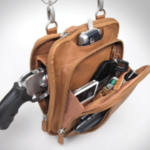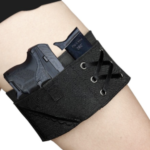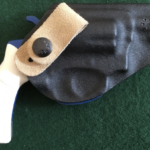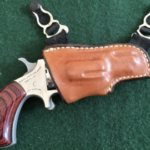PRESIDENT’S MESSAGE
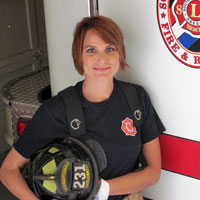 For those of you who know me well, you know that I am not a big fan of snow. I like to go visit it in the mountains, on my terms, and go back to my home in the Willamette Valley, a rain forest oasis sandwiched between the Coastals and the Cascades. It rains a lot but we see very little of the white stuff on the valley floor. That is until recent years when we seem to be seeing more and more of it during February. This year, early in the month the white stuff decided to come visit. Of course it happened on a week that I had to drive up north to go to a conference in Salem on Monday and Tuesday, then turn around and drive to and from Portland on Wednesday. Well, it was all going to be okay because I was heading to the beach Thursday through Saturday of that week…uh, huh. Guess what happened? It continued snowing and it crossed over those Coastals and met me at the beach. Driving home, I ended up with snow and sand in my shoes. For me, this was the final insult. Snow had made it personal and I cursed it. I believe it heard my curses and took a break–to gear up.
For those of you who know me well, you know that I am not a big fan of snow. I like to go visit it in the mountains, on my terms, and go back to my home in the Willamette Valley, a rain forest oasis sandwiched between the Coastals and the Cascades. It rains a lot but we see very little of the white stuff on the valley floor. That is until recent years when we seem to be seeing more and more of it during February. This year, early in the month the white stuff decided to come visit. Of course it happened on a week that I had to drive up north to go to a conference in Salem on Monday and Tuesday, then turn around and drive to and from Portland on Wednesday. Well, it was all going to be okay because I was heading to the beach Thursday through Saturday of that week…uh, huh. Guess what happened? It continued snowing and it crossed over those Coastals and met me at the beach. Driving home, I ended up with snow and sand in my shoes. For me, this was the final insult. Snow had made it personal and I cursed it. I believe it heard my curses and took a break–to gear up.
This last Thursday, after a two week reprieve back into just rainy weather, I headed to Ventura for the PSWA Board Meeting. We started on Friday going over last year’s to-do list to make sure we didn’t miss anything, swearing in our new Board Members (Mysti Berry-Treasurer, Thonie Hevron, Member-at-Large, Scott Decker, Member-at-Large), then doing tech talk. We reviewed the website and made sure we had all the technology we needed to make this year’s writing Conference go off without a hitch. We talked about the Newsletter and how it’s a great venue for your writer’s news and a place to show off your expertise. We finished the day by discussing the annual Writing Contest, including our new “New Voice” award which will be given to a member who enters the contest for their very first time. So, if you have never entered the contest before, regardless of whether you’re a new member or have been around ten years, you could be the inaugural “New Voice” winner this year.
On Saturday, we were back to work discussing the conference, from logistics to the panels to the amazing meals (Chocolate cake for dessert on Sunday? Yes, please!!). Then, we discussed membership and marketing. We want to keep seeing this organization grow and thrive which means each one of us should be sharing the PSWA and its benefits with everyone you know, including through social media. Please like our PSWA group page and follow our Twitter feed as well, then you can share all the great information we’ve posted. Our final topic of the day? We discussed doing another anthology. Like CopTales 2000 and Felons, Flames and Ambulance Rides, this will allow us to highlight our member’s work and the vast amount of talent we have in so many genres.
Sunday, our last day, we talked strategic planning. We discussed our organizational values and how we were meeting the goals of our mission statement:
To provide resources, services, and networking opportunities to writers of fiction and non-fiction in the law enforcement, fire service, and EMS genres. To mentor and educate new and experienced writers. To encourage the creation of memoirs, novels and other fiction and non-fiction literary works, and technical articles and books for public safety personnel.
I tasked each member of the Board to think about everything in their area of responsibility in light of this statement. Then, I asked each person to come up with three ways they could personally benefit the membership. One of my ways, as President was to reach out to, encourage and support other members who write non-fiction trade articles as this is my area of expertise. I got my real start at my first PSWA conference when I pitched Tim Dees, then editor-in-chief of Officer.com and he agreed to look at my work and consider me as a columnist writing about 911 Dispatch. I’m now going on my thirteenth year writing this monthly column and have hundreds of other print and on-line features with my by-line. So, if you are interested in this area of writing, please reach out to me. I’m happy to pass the support I was given on to other members. I’m not alone in this either. All the members of the Board are dedicated to being mentors. Just ask
So, what does this have to do with snow? Well, I was due to fly home from LAX today but due to a magnificent snow storm which knocked out power for thousands, incited the City of Eugene to declare a state of emergency and caused our neighbor’s pine tree to crush my cousin’s car, my flight was cancelled. But, like that old hippie song says, every gray cloud has a silver lining (Wait, that’s backwards but you get my point), I’m now sitting here typing this President’s letter from Phoenix where I got an impromptu visit with my husband due to the only flight to Eugene being out of Phoenix tomorrow evening. So, I suppose I should thank the snow. Even so, it needs to make itself scarce when I finally make it home. So, wherever you are, whatever the weather, whether you like it sunny, hot or icy, cold, I hope that you are writing. I hope that you will enter the contest (especially you newbies) and will sign up for the conference in Las Vegas in July. (BTW, Vegas just got snow too, but I’m hopeful it won’t happen again during our time there.) I should probably abstain from cursing the snow if I want to make sure this doesn’t happen.
—Michelle J.G. Perin-Callahan, MS, QMHP, EMT
President, PSWA
WHAT’S IN A TITLE?

I love titles. When you think about it, it’s one of the most important aspects of a writing project, be it a short story, a novella, a novel, or a nonfiction work. Choosing the right title can often mean the difference between a sale and a rejection, or a work that sells well and one that tanks. I’d be the first to admit that the title is usually what attracts me to a book. Sure, the cover art is important, but if it doesn’t have a good title, I won’t pick it up.
When I do my Executioner series, I write the book with a working title that’s always subject to change. In fact, I have to submit a list of alternate titles that the editors review. Some titles that I thought were dynamite, like Dragon Ships, got dropped. (That one became Death Match, which was then changed to Missile Intercept.) One of my all time favorite working titles was Diamonds Aren’t Forever, which had the bad guy Russians trying to take over the world diamond market. My buddy, Raymond Benson, who wrote the James Bond novels, told me “They’ll never okay that one. It’s too close to the Bond title. Ultimately, he was right and they went with Uncut Terror, but they did use Diamonds Aren’t Forever on the back cover above the teaser.
I plan on having a panel on choosing the right title at this year’s PSWA conference, which is going under the moniker of the Fabulous Fourteen, due to this being our 14th conference. Speaking of which, the early bird discount expired December 31st, but there are still other discounts available.
We’ve extended a couple of great offers this year, including a special discount if you convince two new people to register for the conference. There’s also a “no cancelation” rate. Check them out on the website. It goes without saying that the conference is our main event each year, and I personally think it’s the preeminent event of its type. The price is very affordable, and the hotel rates are extremely reasonable. Make sure you take advantage of the conference rate offered by the Orleans Hotel. The code is posted on the website. I’ve usually found the best way is to call the hotel directly and mention you’re attending the PSWA Conference. The staff is very helpful. The conference is shaping up to be another great one, so make sure you sign up today.
We’ve got some dynamite solo presenters lined up. Retired Deputy Chief Dave Freedland of the Irvine, California PD, will talk about real life SWAT tactics and the various call-outs he was on during his police career. Our PSWA Vice President and retired copper, John Schembra, will give you the low-down on police pursuits and high-speed chases. Author and publisher, Mike Orenduff, author of the highly praised Pot Thief series, will talk about going from an unknown to a best seller. And highly successful short story and screenwriter, Mysti Berry, will show us how to turn real life into fiction by asking the dramatic questions to focus your story.
If those aren’t enough to whet your appetite, I’ve got a bevy of interesting panels one a variety of subjects. Speaking of panels, I’m still taking suggested topics so send any you have to me at DocAtlas108@aol.com. We’ll also have our PSWA bookstore to sell your books and a variety of excellent meals, which are included in the conference. We’re also offering our pre-conference writer’s workshop, where you can get one-on-one feedback and writing instruction from four professionally published writers Mysti Berry, Marilyn Meredith, Mar Preston, and me. Since there’s been so much interest about possibly doing another PSWA anthology, we’re highlighting writing short stories at this year’s workshop, but the writing principles can be applied to any type of writing. You can also have up to 25 pages of your manuscript critiqued by one of the workshop instructors at the workshop. (It’s required that you send it in advance.)
And don’t forget the PSWA Writing Contest, where you can enter both published and non-published works in a variety of categories. Look for an exciting new announcement about the contest in this newsletter.
We’re also planning to have our old time radio play, some publishers on hand, and there will of course be lots fun and stimulating conversation. There’s no better place to rub elbows with the actual experts who’ve walked the walk and know what’s real and what’s not.
Don’t hesitate. Sign up today. You won’t regret it.
—Michael A. Black
Program Chair
New releases by Michael A. Black:
Dying Art (an Executioner novel under the name Don Pendleton)
Marty Quade, Private Detective, featuring Black’s short story, “Dead Man’s Hand”
“Carnivores and Herbivores,” a short story in the June/July issue of Alfred Hitchcock’s Mystery Magazine
Stealth Assassin (an Executioner novel under the name Don Pendleton coming in June 2019)
Legends of the West: A Bass Reeves Novel (Coming in October 2019)
RESURRECTION ON THE CUTTING ROOM FLOOR

The first draft of one of my novels was 135,000 words—1.5 times what was remotely salable. Since I didn’t plan on writing solely for myself, I couldn’t risk being thrown in the circular file before my doorstop even reach an editor’s desk! So I began to cut. In the many subsequent drafts and rewrites, I’ve always had one eye on shrinkability. When my editor—the stellar Barb Goffman—suggested I beef the novel up in some areas, I knew we weren’t just talking addition, we were talking subtraction too.
A number of characters were easy to jettison altogether, but a few that had to be trimmed still spoke to me. The three most promising I’ve turned into published short stories, something J. Todd Scott may have done with a character from High White Sun (a short story in, I believe, Mystery Tribune).
One character I didn’t want to lose is a murdered Roman priest who thinks his classic migraines are communications from God. Although his death remains in the novel, his backstory is repurposed in “The Penitent,” published last year in Bouchercon’s Passport to Murder.
A mafia fence launched his career by masterminding the 1990 Isabella Stewart Gardner Museum heist in Boston, a resume-enhancing crime unrelated to events in the novel. That story became “Above Suspicion,” appearing in the current issue (#26) of Sherlock Holmes Mystery Magazine.
Another priest, Anglican flavor this time, intervenes in an assault on my protagonist, no doubt saving her life. While this priest has only a minor role in the novel, his giddy nonstop talking charmed my beta- (or perhaps I should say gamma-) readers, and I worked him into a story—“What Saved Them”—published in the U.S. 1 Summer Fiction issue.
The transformation from novel excerpt to complete short story turned out not to be as easy as I expected, and each presented its own challenges. If you’re ever tempted to resurrect one of the darlings you’ve just killed, here’s what I learned.
Four Tips for Authors
1. If the characters involved in the short story remain in your novel (that is, if you haven’t gotten rid of them altogether), you need an eagle eye for continuity. You can’t have your character driving a Porsche in the story and relying on Uber in the story. More important, they cannot do anything in the story that would affect the action of the novel.
2. Originally, I’d engaged in vigorous head-hopping in the scene where the priest dies. I found I could park the novel’s point of view in the head of the assassin, yet write the short story from the priest’s perspective. Same events, two points of view. That was fun.
3. The story of the fence had a strong core from the get-go because of the extensive detail about the ISG theft. I wrote new backstory—waybackstory—about the character’s childhood in Fez. And of course more extensive setup and denouement.
4. OK, it’s fun, but is it a story? The Anglican priest was a character. His story had to be developed from scratch using the dialog I’d salvaged. But who was he? How would he behave? What changed for him? The rescue of the woman would plausibly have a long-term impact on him and it became a source of reflection, laying the groundwork for his subsequent actions.
Because you don’t have a blank page when you deal with bits excised from other works, there are many more than the customary limits on your degrees of authorial freedom. Whether the resurrected short stories prove useful in marketing or whether they are just good stories in their own right, you can feel good about creative recycling!
Originally published on www.vweisfeld.com January 16, 2019.
—Vicki Weisfeld
Twitter: @vsk8s
Website: www.vweisfeld.com
DANGEROUS WOMEN
Last fall I made a presentation on holsters for the NorCal Chapter of Sisters in Crime. I offered ways the writers’ characters, both male and female, might carry a gun. We covered holsters from A to S (ankle & appendix to small-of-the-back & shoulder), listing the pros and cons for each type. The many holsters and plastic training guns I brought with me were used in a hands-on show-and-tell.
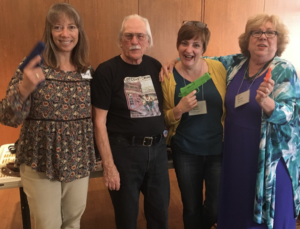
Following are some less conventional holsters intended for women. A quick internet search will show the many brands and styles available.
|
|
|
|
|
|
|
—Jim Guigli
NOBODY WANTS TO TALK ABOUT IT…

“Don’t go gettin’ yourself killed cause six months from now nobody will remember your name.”
That was one of the things my field trainer told me when I joined him for my first shift in a police car. It was 1975 and I was fresh out of the police academy, free at last from classroom theory and eager to try the real thing. Ten minutes later we took our first call. One drunk had thrown another drunk through a storefront window. Welcome to night shift in Vancouver.
He was a good field trainer with 20 years experience. I learned a lot from him. But in those days we didn’t talk about the effect police work was going to have on us. We talked a lot about officer safety but not about mental health safety, protecting our psychological well-being as well as our physical selves. The term Post Traumatic Stress Disorder wasn’t even in our vocabulary.
But it sure is now. PTSD is a live issue for today’s first responders. It’s something to think about as we develop our first responder writing characters. My protagonist could have PTSD. That would add another dimension to the character I’m creating in my story.
For me, PTSD evolved over time. Back in the police academy we were taught never to react emotionally at the scene of an incident, no matter how awful it was. It was explained to us that if our emotions took over we couldn’t be of any use to anyone else. Tamp your emotions down, deal with the call you’re on, write your report, and take the next call.
On a busy night we raced from call to call to call. There was no time to talk about our experiences or properly debrief. In fact, nobody really talked about any kind of a psychological debriefing. It was more “suck it up and get on with the job.” The dispatchers were stacking calls and we were dealing with them as fast as we could.
The trouble was, it all built up inside us and caused problems later in life.
For those who have PTSD writing helps process those memories that have been suppressed. It can be an important part of dealing with PTSD as long as we really let our emotions flow to the page and don’t write like it’s a police report. That’s not as easy as it sounds as we’ve been trained and conditioned for years to write in an unemotional way about incidents we attended.
There’s lots to write about. The suicides, murders, and motor vehicle accidents, all part of the human drama patrol officers face every shift.
After I’d had my fill of patrol work I moved on to the excitement and challenge of specialty squads like the Strike Force, a surveillance team. Then an undercover assignment far from mainstream policing, out of sight for six months, working among the criminal element.
Does it all sound scary and stressful? Sometimes it was but it was also satisfying and I enjoyed most of it. I just wasn’t prepared for what came later, after I retired.
Nightmares.
All those sights, the stress, and the fear I’d tamped down started coming out as night terrors. My day time brain thought the gruesome sights and fear inducing incidents were over but my night time brain had other ideas.
Avoidance is common to PTSD. We tend to avoid talking about it. We think others might have PTSD but not us. We also don’t feel entitled to have PTSD. I was a first responder but my reasoning led me to think others, such as soldiers who have been in combat, are entitled to have it but not me. I seriously did not want to admit I had PTSD even when I checked a lot of the boxes on the symptoms checklist.
I’ve got some retired first responder pals, mostly police but some firefighters too. Picture us sitting around a table in a coffee shop, which happens frequently. They’re a great bunch and have lived interesting lives. We’ve got a million stories but you can bet we’re not talking about PTSD. Any discussion of our working life is likely to be about the big cases, the exciting times, the drama. And of course office politics. Not PTSD.
Nobody wants to talk about it. Too sensitive a topic, too revealing for a bunch of tough first responders, too touchy-feely.
This morning my wife and I were at Starbucks, a favorite spot for our city Fire Department members to take a break. There were four of them sitting there enjoying their morning coffee while a big red fire truck was parked nearby. My wife, who has lived with my nightmares for years, said quietly to me: “I feel like telling those firefighters ‘you guys are going to be so f*^~ed up when you get to the end of your careers.’” It might seem like a cynical comment but those words come from the insight of a weary spouse who has seen the effects of a first responder’s work life.
Now we’re all different so I’m not saying all first responders end up with PTSD but I believe a lot do. I need to say too that I can only tell you about my own personal experience with PTSD and what I’ve learned from knowing other first responders well. I’m not a psychologist and have no training in that field.
Thank goodness first responder organizations deal with this trauma better now than they did years ago. There are more resources available to get help from and some police leaders are talking more openly about mental health issues. I know of police departments that have annual compulsory debriefings with a psychologist.
What would I tell our current police officers about PTSD? Based on my experience there is one piece of advice I’d give a young police officer today. Deal with the awful stuff as you go along. Don’t save it up. Talk about it. Write about it, even if nobody sees your writing. Seek treatment from a professional who is trained and experienced dealing with PTSD. Don’t suffer alone.
—John Eldridge
Retired Police Officer
Author of Second Careers for Street Cops
HOW TO SAFELY USE A GUN FOR SELF DEFENSE

If you are a CCW (Carry Concealed Weapon) holder, then this discourse will be fairly common and basic information. However, I would imagine there are some PSWA members who don’t like guns, are afraid to use them, and/or have never fired a gun. Thus, my focus of discussion will not be pro or con on the “hot topic” of gun control in America. Rather, if you are a homeowner and choose to have a gun in the house for protection, my intention is to address some personal safety guidelines.
One of the primary reasons we CCW holders carry a gun when we’re out is to be safe, prepared, and protected in any situation. But with the increasing number of burglary, robbery and home intrusion cases, more homeowners are making the decision to have a gun in the house to fortify the defense and security of their homes and for protection of self and loved ones.
Here’s some quick facts that might (or might not) surprise you:
- 2,000,000 home burglaries are reported each year in the United States.
- Nearly 66 percent of all burglaries are residential (home) break-ins.
- 85% of break-ins are from non-professionals that are usually more desperate and dangerous.
- The DOJ reported the use of weapons in a majority of robberies: 41% of robberies involved firearms and 7.8% included knives or other cutting devices.
Personally, I believe that owning a gun is one of the best home defense strategies that homeowners can employ. Maybe this is due to my background in law enforcement and the military. However, protecting the home and loved ones requires more than just purchasing the right type of guns and ammo.
Regardless of your expertise, often additional skills are needed in order to properly (and safely) use a handgun for self-defense. Like I said before, some of this may be fundamental to those reading this with a lot of experience, but it’s always good to have a refresher.
1. Keep your finger off the trigger.
If you are encountered suddenly by someone forcibly entering your home, your adrenalin is going to “rocket sky-high”. Even professionals who handle weapons regularly keep their finger off the trigger until the moment they need to fire. This practice has prevented many accidental discharges and injuries. When fingers are kept off the trigger, the person is given enough time to think his (or her) actions through. This will prevent you from acting based on emotions like fear.
This practice is especially important when other people are in the house. It may be counter-intuitive, but practice keeping your finger off the trigger until you’re sure that the gun is directed at the intruder (and not at grandma or junior).
2. Equip the handgun with a light.
The majority of the home defense handguns available today have the capability designed to accept different types of accessories such as lights, red dot sights, or lasers. There are a couple different thoughts on this.
Some safety professionals recommend putting a light on the gun explaining that it can help you see where you’re going and even blind the intruder for a moment while you fix your position. It also helps ensure that your “intruder” is an adversary and not your teenage daughter sneaking in her boyfriend after curfew.
Personally, I don’t like this “gun light” idea. You know your house better than the intruder and can likely navigate around furniture at night without turning on room lights. This gives you a distinct “home-field advantage.” Using a light attached to the gun serves only to give away your exact position to the intruder. If you want to make sure the intruder is someone not belonging in your house, the flip-on a room light to quickly identify your intended target before assessing the need to fire your gun.
3. Keep hollow point rounds and low grain ammo in mind.
When high powered or full jacket rounds are used the bullet has a big risk in going beyond the target, through the walls, and into a room possibly injuring a family member. Some rounds can even go through outer walls and into neighboring residences. In order to avoid this, the bullet can be slowed down by using a lower grain round.
With this thought in mind, some homeowners prefer shotguns over handguns. They are a little more awkward in handling, but you don’t have to be as accurate and the rounds are less wall-penetrating.
4. Look at what is BEHIND the target.
In addition to ensuring that rounds will not go where they shouldn’t, the people holding the gun must also first determine if there is something or someone behind the target and to identify who or what it is. Bullets have a tendency to go beyond their target regardless of caliber. By knowing what may be behind the target, the risk of hurting an innocent person is reduced. Additionally, a frangible hollow point round can be used to ensure that the bullet stops in the target… not somewhere behind it.
Honestly though, this is probably the least of all considerations you will have when faced with the decision to fire a weapon at an intruder. In times of fear, you are probably going to have “tunnel vision” and only see the intruder and any weapon (or object) in hiss hand that is threatening to you.
A word of caution… it has been proven to every law enforcement agency that a “rival or foe” with a screwdriver, hammer, or knife can cover a distance of approximately 21-feet before the average person can get off a shot from a gun. Most rooms are less than that distance. Don’t hesitate when coming face-to-face with the “bad guy”. Those who hesitate lose.
The Bottom Line
Using a handgun for home defense requires more than basic handgun knowledge. It’s a big responsibility and it requires you to develop situational awareness in order to ensure that no innocent people will be hurt.
This is most especially true when handguns are being used for self-defense. Firing a gun inside the home entails bigger risk and will therefore, require a bigger responsibility to the user.
Liability can be reduced by frequently practice firing your weapon. Practice under low-light conditions. Practice shooting with both hands. And don’t forget to keep your weapons out of reach, or stored in a child-proof area.
Stay Safe,
—Ron Corbin
phdav8r@yahoo.com
CHALLENGE COINS

Are you looking for a unique way for people and customers to remember your business or organization? Challenge coins may be the answer you’re seeking. With a history that reportedly dates back to The Roman Empire, challenge coins are presented with pride and often treasured by recipients. History indicates the coins’ modern day popularity probably began during World War I, when a flying squadron commanded by a wealthy lieutenant ordered medallions for his unit. Other reports claim the coins became popular during World War II. Regardless, there’s no denying the interest of this cherished piece of metal.
What is a challenge coin? It’s a small coin or medallion that identifies an organization, unit, company, or agency. Those who carry such a coin use it as proof of membership in that company or unit, particularly if challenged by someone. These handouts have also proven to boost morale and enhance loyalty and fidelity. Most people who’ve been issued or given a coin carry it in their pocket, although some wear it around their neck. Either way, the coin is carried each day in the event someone challenges that person’s inclusion in a particular unit or company.
To get a current perspective on challenge coins, I went to the source, a local veteran owned business, Coins for Anything, Inc., located in Spotsylvania, Virginia. Owned by two Marine Corps veterans, Jeff Morin and Chris Frederick, they’ve been in business for fifteen years. Jeff started the company while still in the Corps. He’d buy challenge coins on the internet and then resell them at a profit. When a potential customer requested a “Mother of a Marine” coin, Jeff was unable to find one. He decided then to design and produce this special coin himself, giving birth to his successful business.
Although the genesis of the challenge coin was strictly military and symbolized bonds cemented during battles, the coins produced and traded today also represent first responders, companies, and special events and occasions. Milestones reached in business such as extraordinary sales or productions, are perfect to memorialize with a special coin. Athletic events such as the Marine Corps Marathon and Army Ten Miler hand out special coins in a keepsake box for all finishers.
I asked Jeff and Chris about a typical order, if there is such a thing. They told me orders can range from one coin to 80,000. Orders generally take three weeks to produce and customers work online with staff to finalize artwork and view a final proof before placing the order. The coins’ basic metal is brass, but can be covered in silver or other coatings. The most popular coin is antique brass. There are three sizes: 1.5”;1.75”; and 2”. The most popular size is 1.75”. Coins don’t necessarily have to be round, although that shape comprises most of their business. Odd shapes such as a skull or badge are no problem to produce, and they can also create lapel pins, cufflink sets, and belt buckles. Production will normally take three weeks to complete. Coins can be made in 2D and 3D which allows for a deeper relief and more intricate details.
The popularity of these special handouts has skyrocketed. Whereas the military formerly used the coins to promote their branch and units, outside entities have embraced the theme of creating their own challenge coins. Some of the groups that have created their own coins are: National Association of Buffalo Soldiers and Troopers Motorcycle Club; Harley Owners Group; International Genetically Engineered Machine competition; ABC News; and the movie, Iron Man 2. One of the rarest coins today is the Bull Dog coin. It was presented to B-52 tail gunners only. Unfortunately, that position was phased out in 1991 which made the Bull Dog coin a collector’s dream.
A late entry into the challenge coin arena is the Canadian Armed Forces. The Canadian Airborne Regiment adopted their coin after returning from Cyprus in 1974. And the concept has also found favor with police, security, and fire departments in Canada. Many of their coins feature a patron saint and are used to promote team building and a sense of brotherhood.
Challenge coins aren’t just for so-called ordinary folks. President Clinton was given a number of coins from U.S. servicemen. He proudly displayed them in the Oval Office, and the collection now rests on display in the Clinton Library. President George W. Bush received a challenge coin from a Marine in 2007 during a visit to Iraq. Since the 1990s, presidents have issued their own challenge coins. President Trump’s coin includes his campaign slogan, “Make America Great Again.”
Are you considering launching a new product? A challenge coin is a great way to give it a polished look and increase its value without increasing the price. How about recognizing employees or students for their superb accomplishments? Giving them a special coin is a way that ensures they’ll always remember. Are you thinking of participating in a job fair or trade show? Handing out challenge coins at the event is a great way to improve your brand recognition.
Putting your unit or business on a coin or other shape ensures that person will likely remember you and your company. Unlike business cards that get lost or tossed, challenge coins manage to stand the test of time. Think about the possibilities next time you’re hoping to capture and keep someone’s attention.
—John M. Wills
Award-winning Author/Freelance Writer
Public Safety Writers Assoc member
www.Jwillsbooks.com
BACKSTORY? HOW MUCH, HOW LITTLE, WHEN….AND MORE
 A story is written in two parts: backstory and front story. Front story covers events happening in the present and accelerating to that thrilling conclusion. Backstory reflects past events and all the influences that ripple outward from them. Backstory will deepen your readers’ enjoyment of your characters and plot and enrich a story that they remember. But feather it in as a seamless part of the story, not something parachuting in from outside, like the deus ex machina in Greek tragedies.
A story is written in two parts: backstory and front story. Front story covers events happening in the present and accelerating to that thrilling conclusion. Backstory reflects past events and all the influences that ripple outward from them. Backstory will deepen your readers’ enjoyment of your characters and plot and enrich a story that they remember. But feather it in as a seamless part of the story, not something parachuting in from outside, like the deus ex machina in Greek tragedies.
Deux ex machina means a plot device in which an unsolvable dilemma is miraculously resolved by the unexpected intervention of some new event, character, or a previously unknown ability on the part of a character, or even an object. A letter arrives from a rich uncle who leaves the hero enough money to save his hardware store. Or the revelation that the hero is an expert marksman who shoots the gun out of the hand of the villain fleeing before him. (Very improbable I’ve learned at PSWA).
Backstory deepens an appreciation of the context of your characters and setting. Once readers understand characters’ struggles, they care about what happens to them. They’ve seen cause and now effect. This happens because of that.
But backstory isn’t now. By definition, it drops back into then. Done ineptly, it slows the unfolding of the front story, and may even leach the emotional power out of the action unfolding on the page in the story’s present.
Backstory yanks the story into the past, away from the readers’ engagement in the world you’re building paragraph by paragraph, page by page. Whatever technique you use, dropping in a chunk of backstory to explain everything that happened in the past stops the story’s forward momentum, and jars readers. What you’re aiming for is that wonderful experience of looking up from the pages of a book where you’d been racing along on the back of a horse chasing a poacher through the Badlands to find yourself lying on the couch in your living room.
Do you explain about the killer’s being locked in the closet as a child? There are many ways to slide in this fact at exactly the right time, at exactly the right place. A passing reference to the back story may be all you need.
How much backstory? Imagine your hero telling his life story to an attractive woman he’s met on Match.com. He’s going to tell just enough to intrigue, yes? In fiction, he might let slip a nuance that foreshadows what is to come, or show us by inference what his driving needs are. You want to make the reader curious enough to want to know the past, and to find out by turning the pages.
—Mar Preston
For More: https://www.amazon.com/Writing-Backstory-Mystery-Fiction-First-ebook/dp/B072R3PWV1/
SUSPENSION OF DISBELIEF
 “Willing suspension of disbelief” is a term coined in 1817 by the poet and aesthetic philosopher Samuel Taylor Coleridge, who suggested that if a writer could infuse a “human interest and a semblance of truth” into a fantastic tale, the reader would suspend judgment concerning the implausibility of the narrative.
“Willing suspension of disbelief” is a term coined in 1817 by the poet and aesthetic philosopher Samuel Taylor Coleridge, who suggested that if a writer could infuse a “human interest and a semblance of truth” into a fantastic tale, the reader would suspend judgment concerning the implausibility of the narrative.
Every fiction writer must wrestle with this at some time. The worlds we create are products of our imagination with a little fact thrown in.
The main facet of suspension of disbelief: Could this happen, really?
Something that I see in my genre (police procedural/thriller/mystery) so often is multiple officer involved shootings (OIS’s) several times a shift or day or week. Officers never seem to go on Administrative Leave ever. As many of you know, Administrative Leave is a temporary leave from a job or assignment, with pay and benefits intact. Officers are routinely placed on administrative leave after a shooting incident while an investigation is conducted (sometimes by an outside agency for impartiality), without implying fault on the part of the officer. This is the norm in modern police work. To show characters going from one shoot ‘em up to another defies belief.
Cops and fire fighters are readers and know when something just ain’t right. My husband, the retired firefighter, cries foul when a vehicle is involved in a crash and explodes (this doesn’t include when the plot specifies an incendiary device was aboard). What typically happens is this: cars don’t explode on impact. If they catch fire, it’s often due to fuel leaking to an ignition source (such as an overheated catalytic converter). But when you include a feasible ignition source in that Impala that collides with a tree—then you have the “well, it could happen” moment.
Another part of suspension of disbelief involves the premise of my first novel. By Force or Fear’s protagonist is a female detective being stalked by a cunning judge. Her superiors didn’t believe her when she reported him. In this day of #MeToo, I seriously doubt any responsible administrator would discount the report. But it could happen, right? Create the right motive for the Administrator to hide the report and that’s suspension of disbelief.
The key to making the preposterous believable is to sow seeds of reasonability into the story (foreshadowing) ahead of time or during the event. For instance, an observer of the car crash might see the fallen tiki torch next to the tree or the officer may be the last officer (think a department-wide epidemic with no mutual aid officers available within the day—hey, it’s a stretch but it could happen, right?). Sometimes a scientific explanation after the event can work but that can be dicey. Balance this with authenticity.
The trick to all of this is to make your devices (and plot twists) believable. Do your research, online and on the ground. Talk to police officers, fire fighters, professors, whoever you need to get the scoop. After talking to these folks, you may find that the truth is less believable than fiction!
For any genre, fiction or non-fiction, the Public Safety Writers Association is one of the most phenomenal resources at a writer’s fingertips. Jump on the listserve and ask your question. You’ll be amazed at how many replies you get!
–Thonie Hevron
Award winning author of By Force or Fear; Intent to Hold, With Malice Aforethought.Website: Thonie Hevron blog: Just the Facts, Ma’am
NAILING NAIL GUNS

In Good People (2013 — spoiler alert), the latest of a half-dozen films I’ve seen that feature a nail gun used as a weapon, they get it half right. In this film the everyday hero is played by James Franco, who is renovating an old house when he crosses some murderous criminals. He hides in the house’s basement while he listens to a bad guy walk the wooden floor above his head. When the man stops right above him, Franco pushes his nail gun up against a floor board, pulls the trigger, and drives a nail up through the wood into the bottom of the man’s foot.
That was done right because, unless safety parts are removed, all nail guns, whether powered by air, electricity, or chemical charge, must be pressed against something solid before they can be fired. There is a piece at the tip, the nose contact, that is part of the safety system. And James Franco did press the nose contact to the floor board before he pulled the trigger.
But Franco’s second use of the nail gun reverts to the familiar action-film fantasy of using a nail gun to shoot a nail through the air like a bullet. This time he looks up through a knothole in the floor board and shoots a nail through the hole up into the forehead of another bad guy. The shame here is that he could have pressed the nose contact against the edge of the floor board hole and still fired through the hole, but he didn’t. Just pulling the trigger is supposed to fire the nail gun. The rest of this action-film fantasy is that you could precisely hit something that is six feet away. Nail guns resemble guns in that they have triggers, but they don’t have sights for aiming, and the flight path of nails over distance is uncertain. But, in action films, hey, it could happen.
If you want to use a nail gun in your story, remember that, without modification, nail guns must be pressed against something solid before they will fire. Two standard types of nail gun firing sequences are:
- The full sequential-trip trigger, which requires nose contact before the trigger is pulled. This is the safest system.
- The dual-action contact-trip trigger requires both nose contact and trigger pull, but in any order. If the trigger is pulled and held, the gun will fire upon each contact. But recoil may cause several nails to be fired before the trigger can be released (bump-fire). This system trades safety for work speed.
So, how do you allow your protag/antag to shoot nails through the air yet be technically correct? The nose contact can be pulled back by hand. This will simulate the required contact with a solid surface and allow pulling the trigger to fire nails through the air. It’s a tad risky because the fingers pulling back the nose piece are very near the hole from which the nail will emerge.
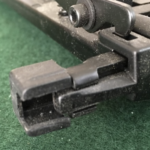
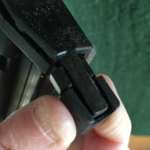
The photos above are of a “pin gun,” which shoots headless metal pins, but the operation is the same as that of larger nail guns. The left photo shows the nose contact in the normal extended position. The right photo shows the nose contact manually held back so that the gun can be fired by just pulling the trigger. 
Nail guns shoot fasteners that range in size from tiny 23 gauge (.025”diameter) x 1/2” long headless pins used to temporarily hold together pieces of wood together during gluing, up to 3-1/2” x 15 gauge (.13” diameter) headed construction nails used to join large pieces of lumber.
Consult the internet and visit a Home Depot store. Then pick your poison.
Wikipedia’s section on nail guns has a nice nail gun safety video showing these different safety systems in action. ( https://en.wikipedia.org/wiki/Nail_gun )
—Jim Guigli
MEMBER NEWS
Sarah Cortez
“More than twenty years ago, I left a flourishing corporate career to strap on a gun, wear a badge, and police the streets. Transitioning from Italian high heels and a gleaming high-rise to the interior of a low-bid, threadbare Crown Victoria was exactly what I wanted—and had eagerly anticipated. The price was high—a radical pay cut, a divorce, loss of social status—but not unexpected. It is the best thing I’ve ever done.” —Sarah Cortez
Joining the ranks of the Thin Blue Line was a decision that author-cop and Rice graduate Sarah Cortez has never regretted. Now, after 24 years of experience in both state and county agencies, she brings every reader inside the police car with her and into havoc of street policing.
Quotes from law enforcement professionals about Tired, Hungry, Standing in One Spot for Twelve Hours: Essential Cop Essays
Cortez’s writing will resonate with law enforcement professionals—from the adrenaline-inspiring memories of the police academy to the everyday chaotic scenes of crime-fighting. The best features of her writing are her authentic voice, her passion about the “calling” of police work, and the concise language she utilizes—as only a gifted writer can. This book is a good reminder to all of us of why we wanted to be police officers in the first place. –Lieutenant Betsy Randolph, Oklahoma Highway Patrol
www.sarahcortezcop.com
www.poetacortez.com
M. Glenda Rosen
Book Two of The Senior Sleuths Mysteries
“Thanks to my father, writing mysteries is in my DNA!
My father was a gangster. Really!”
Like Nick and Nora Charles from The Thin Man series, Dick and Dora Zimmerman from The Senior Sleuths solve crimes, especially murders. Along with Zero the Bookie (fashioned after the author’s father) and a fascinating cast of other characters (such as Frankie Socks fresh out of the Witness Protection Program), the Zimmerman’s ignore being told to stay away!
As the story begins, the Las Vegas Sheriff is not happy to have Dick and Dora back in his town, especially since they had arrived on a plane with a dead body. Zero had brought along Cloud, a woman he recently met on an online gambling site. Dora soon discovers what she’s really after.
In Book 2, Dead In Seat 4-A, readers are swept along with Dick and his friends in their frantic pursuit of his wife, Dora, who has been kidnapped along with Cloud, and taken to The Mob Museum. Can anyone save them from the bad guys?
The story includes a poisoned flask, a mysterious key and enough dangerous characters to keep the reader guessing who is really behind the murders. The action takes place in casinos, bars, the condo complex where Dick and Dora live, the airport, the famous Vegas Strip (the scene of car chases), the underbelly of Las Vegas and, in The Mob Museum.
M. Glenda Rosen frequently speaks about writing mysteries and growing up as “the gangster’s daughter.” Numerous articles by her have been published in Mystery Scene Magazine, Sisters In Crime newsletters, and mystery blogs. She has previously published four books in her first mystery series, Dying to Be Beautiful. She is also author of The Woman’s Business Therapist, and the award-winning My Memoir Workbook. She is a member of Sisters in Crime, Board Member, Woman’s National Book Association, Central Coast Writers, Public Safety Writers Association and The Mob Museum.
Level Best Books has also re-released Book One: Dead In Bed, with a new cover and special Ebook price for February 2019. Published in 2018, it received honorable mention, Public Safety Writer’s Association, 2018, and Las Vegas Writers Festival, 2018. Book Three: Dead In THAT Beach House, is to be published in 2020. Level Best will also publish a special 2019 holiday book by the author and her son, The Gourmet Gangster: Mysteries and Menus, by the family.
For more information about M. Glenda Rosen and her work, please visit her website, www.theseniorsleuths.com, or her publisher’s website, www.levelbestbooks.com.
Lynn Hesse
Lynn’s booksigning for Another Kind of Hero and Well of Range in Paloma Landing Retirement in New Mexico was attended by about 40 people. Many books were purchased.

More BIG NEWS: the anthology Me Too: Crimes Against Women, Retribution, and Healing will be published by Level Best and launched at Mysterious Bookshop in New York City on Sept. 24, 2019. My short story “Jewel’s Hell” will be in the anthology along with stories by authors like Julia Pomeroy, Elizabeth Zelvin, and Eve Fisher. https://bit.ly/2Di5iAP
Gregory Lee Renz
Gregory is happy to report that his new book, Beneath the Flames, is being published by Henschel Haus Publishing in July.
About the book:
Beneath the Flames is an intimate combination of love, race, and life as an urban firefighter.
A fire in a neighboring farmhouse has young farmer and volunteer firefighter, Mitch Garner, blaming himself for the tragic outcome. He loses all hope of forgiving himself. His only hope for redemption is to leave Jennie, the girl he’s loved since high school, and journey from Wisconsin’s lush farmland to the decaying inner city of Milwaukee to prove himself as a professional firefighter.
Mitch is assigned to the busiest firehouse in the heart of one of the most blighted areas of Milwaukee, the Core, where he’s viciously hazed by senior firefighters. He struggles to hold it together at horrific scenes of violence and can’t do anything right at fires. Within weeks, he’s ready to give up and quit. His salvation comes in the form of a brash adolescent girl, Jasmine Richardson. Mitch is assigned to tutor her little sister through a department mentoring program. Despite Jasmine’s contempt toward Mitch, her courage and devotion to her little sister inspire Mitch to stay and dedicate himself to helping her and the neighboring children overcome the hopelessness of growing up in crushing poverty.
Trouble on the farm has Mitch torn between returning home to Jennie and staying in Milwaukee where he’ll be forced to risk his life to protect Jasmine from the leader of the One-Niner street gang.
Dave Freedland
Dave is announcing the publishing of his 2nd novel, “The Pepper Tree.” The story takes an actual California landmark known only to law enforcement, which earned a reputation as a site chosen by infamous serial killers to leave their victims. Protagonist, Lieutenant Scott Hunter must lead a team of detectives to identify and capture a perpetrator who’s targeting young women, and has selected this landmark to showcase his victims. The book is published by Aakenbaaken & Kent.
Deputy Chief of Police (Retired), Irvine Police Department
www.davefreedland.com
Mysti Berry
Mysti is speaking on a panel at Left Coast Crime in late March. She’ll share what she knows about thrillers. If you see her there, come on up and say hello.
